Cultivating Public Perception and Policy Initiatives: Understanding the Impact of Environmental Journalism through Focus Group Discussions and Secondary Data Analysis
1
School of Media Studies,
Presidency University,
Bangalore,
Karnataka
India
2
School of Journalism and Mass Communication,
IMS,
Noida,
Uttar Pradesh
India
Corresponding author Email: ashas615@gmail.com
DOI: http://dx.doi.org/10.12944/CWE.19.3.34
Copy the following to cite this article:
Rashmi C. P, Jain L, Sharma A. Cultivating Public Perception and Policy Initiatives: Understanding the Impact of Environmental Journalism through Focus Group Discussions and Secondary Data Analysis. Curr World Environ 2024;19(3). DOI:http://dx.doi.org/10.12944/CWE.19.3.34
Copy the following to cite this URL:
Rashmi C. P, Jain L, Sharma A. Cultivating Public Perception and Policy Initiatives: Understanding the Impact of Environmental Journalism through Focus Group Discussions and Secondary Data Analysis. Curr World Environ 2024;19(3).
Download article (pdf)
Citation Manager
Publish History
Select type of program for download
| Endnote EndNote format (Mac & Win) | |
| Reference Manager Ris format (Win only) | |
| Procite Ris format (Win only) | |
| Medlars Format | |
| RefWorks Format RefWorks format (Mac & Win) | |
| BibTex Format BibTex format (Mac & Win) |
Article Publishing History
| Received: | 2024-06-24 |
|---|---|
| Accepted: | 2024-09-25 |
| Reviewed by: | 
 Peer Muzzammil
Peer Muzzammil
|
| Second Review by: |

 M. M. Sheikh
M. M. Sheikh
|
| Final Approval by: | Dr. Gopal Krishan |
Introduction
In a time characterized by biodiversity loss, climate change, and urgent environmental issues, journalism plays a crucial role in influencing public opinion and advancing legislative efforts.1 Because of its exceptional ability to make difficult scientific concepts understandable to a wide audience, environmental journalism has a significant impact on how society views environmental challenges. This impact has the potential to spur policy changes and steer public policy toward environmentally friendly, sustainable practices.2 Understanding the connection between environmental journalism, public opinion, and policy development, our research uses two distinct approaches to investigate this relationship: secondary data analysis and focus group discussions.
Climate change has far-reaching effects on societies around the world, making educated public participation and effective policymaking essential to reducing environmental problems.3 The ways that environmental journalism influences public opinion as well as the creation of ecologically friendly legislation, however, are still not well understood. By examining the relationships between environmental journalism, public views of environmental concerns, and the ensuing policy consequences, this study aims to close this gap.4 As the twenty-first century progresses, we discover that we live in a world with unparalleled connectivity and communication. Environmental problems are no longer limited to isolated regions of the planet; instead, they are instantly communicated to our televisions, newspapers, and social media feeds.5 These problems range from air pollution and deforestation to biodiversity loss and climate change. Environmental journalism influences how people view and respond to these grave concerns by transforming scientific discoveries into gripping stories. Acting as a link between the public and the complex world of environmental science, it can generate unprecedented levels of action.6 7
Environmental journalism has an impact that goes beyond simple information sharing; it affects the formulation and execution of policies from the ground up. Policies can create significant change and pave the road for sustainability, whether they are implemented at the local, national, or worldwide level. Nonetheless, there are a variety of driving forces and supporting elements behind the creation and implementation of these policies. The media is crucial in deciding the direction and scope of environmental policies because of its capacity to set agendas, influence public opinion, and inspire group action.8
Clarifying the intricate connections between environmental journalism, public opinion, and the policy-making process is the aim of this research. Our goal is to raise awareness of these interdependencies among the public, media, and legislators so that we can eventually create a future that is more ecologically sensitive and sustainable. By supporting proactive environmental policy initiatives and educated public decision-making, the study's findings may steer environmental journalism toward a more significant and positive position in society.
Objectives
This study aims to accomplish two main goals. First and foremost, we want to learn more about how environmental journalism affects how the general public views important environmental concerns. To frame environmental narratives, shape people's attitudes, and promote awareness of the ecological issues confronting our world, the media is essential. We want to explore the complex relationships between media coverage, journalistic approaches, storytelling and people's awareness, attitudes, and behaviours related to the environment through focus group discussions.
Secondly, we aim to explore the impact of environmental journalism on the formulation and execution of policies. In a time when the health of our world depends on sustainable environmental policies, it is critical to comprehend how media narratives influence the creation of these policies. We will examine past and present case studies using secondary data analysis to determine how media coverage affects legislative agendas, policy agendas, and government actions.
Review of literature
Environmental journalism serves as an essential conduit between scientific discoveries and general public comprehension. It can present environmental issues in a way that appeals to a wide range of people. Studies like the one conducted by McComas & Shanahan, 1999 on how the media frames climate change9 show how word choice and framing can influence public opinion. Furthermore, scholars such as Boykoff & Boykoff, 2007 have emphasized the media's function in informing the public about climate change10, both accurately and maybe incorrectly. This implies that the public's perception and reaction to environmental issues can be greatly influenced by environmental journalism.
An active field of research is how environmental journalism influences the creation of policy initiatives. Research on how environmental journalism influences policy change11, such as that done by Hansen & Machin, 2013, shows how media coverage can spur changes in environmental policy. Additionally, Anderson's, 2009 research emphasizes how the public's support for environmental measures is influenced by the media12. This body of work shows how environmental journalism can educate and inspire the public and policymakers to pursue sustainable policy choices.
It's crucial to comprehend how environmental journalism affects the world at large, especially in light of international conferences and initiatives. Research shows that the media can shape how environmental issues are presented at international conferences and have an impact on policy choices.13 The research highlights that major events may lead to limited changes in public opinion, emphasizing the significance of studying segment-specific and content-specific media effects in understanding the influence of media on climate change perception.
Numerous studies have successfully examined the impact of media on public perceptions and policy outcomes by combining focus group discussions with secondary data analysis as a research methodology.14 Environmental journalism does not only shape public attitudes but also influences policy initiatives. Policymakers often rely on media coverage to gauge public sentiment and prioritize environmental issues. Studies have shown that media coverage can lead to policy changes, increased funding for environmental programs, and the introduction of new legislation. However, this relationship is not always straightforward, and research indicates that the media's influence on policy decisions can vary based on factors such as the political landscape and stakeholder interests.15
The importance of ethical climate change communication has been highlighted by earlier studies in the field of environmental journalism, particularly in areas like Pakistan that are severely affected by climate change. Scientists studying climate change anticipate serious economic consequences, extinctions, and ecological risks as a result of global warming. The research that follows focuses on the ethical obligation of journalists to report on issues that go beyond impact and statistics, promoting responsible journalism that educates the public and decision-makers while emphasizing solutions. It presents the ethical standards for climate change communication established by UNESCO. It also looks at the responsibilities that many players play in Pakistan's environmental deterioration and air pollution, including transportation, agriculture, poverty, and population.16 These studies concentrate on the difficulties third-world countries face in providing environmental journalism.
Materials and Methods
The present study utilizes a thorough methodology to examine the complex interplay of environmental journalism, public perception, and policy actions. It aims to comprehend how public perceptions of the environment are shaped by media narratives and how this influences policy decisions. This study combines quantitative and qualitative methods in a mixed-methods approach. Focus group talks and secondary data analysis are used to present the study problem comprehensively. One focused group discussion was conducted. The FGD was divided into two groups, one comprising six participants and the other had seven participants. Heterogeneous cohorts of participants are chosen, encompassing a range of demographics and viewpoints. Interview instructions that are semi-structured will encourage conversation about environmental issues that are reported in the media. To create an extensive dataset, a variety of secondary data sources will be consulted, such as media archives, policy documents, and public opinion surveys. Strict data-gathering procedures will guarantee the accuracy and quality of the data.
The study used content analysis to closely examine media narratives, focusing on environmental journalism's framing, tone, and main ideas. The focus group data is subjected to thematic analysis to identify recurring themes and viewpoints. To find relationships between media exposure and public perceptions, quantitative analysis is used to examine public opinion data.
 | Figure 1: Flowchart of research methodology adopted
|
Result and Analysis
Focused group discussion
FGD was combined, and a Nvivo analysis was then carried out. Sentiment analysis and word analysis were done. The attendees answered a total of ten questions. The first question was “How do you personally define environmental journalism, and what role do you think it plays in shaping public perception and policy decisions?" was the first question posed by the group. When asked what role environmental journalism plays in influencing perception and policy, respondents used terms like environmental, environment, environmental journalism, public policy, and so on, as can be seen in Figure 2 which illustrates the word cloud. One may use these terms as a hashtag to look up environmental policy and journalism. Figure 3 suggests that, on the whole, people support environmental journalism's ability to influence public opinion and policy. The program examined eight replies that were moderately positive and seven that were positive.
 | Figure 2: Word cloud of public perception and policy decisions
|
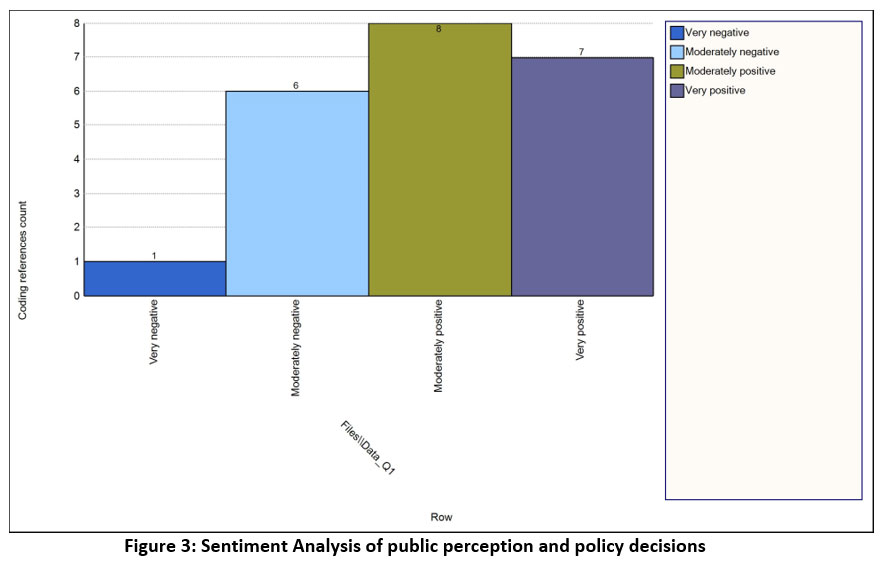 | Figure 3: Sentiment Analysis of public perception and policy decisions
|
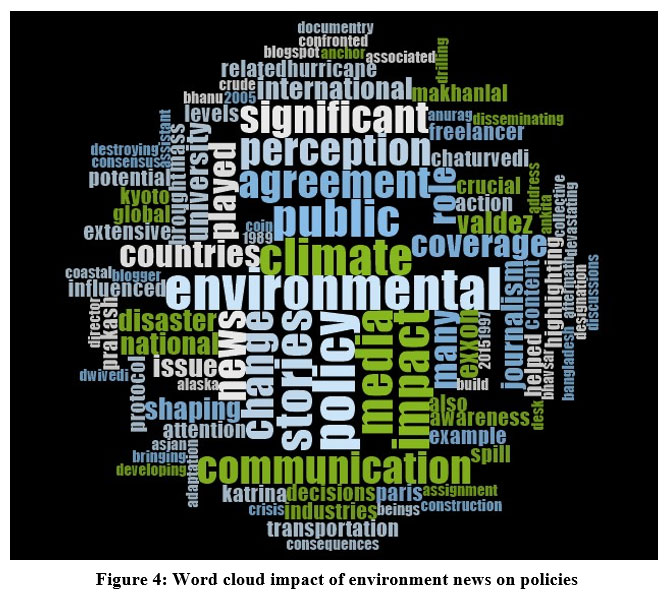 | Figure 4: Word cloud impact of environment news on policies
|
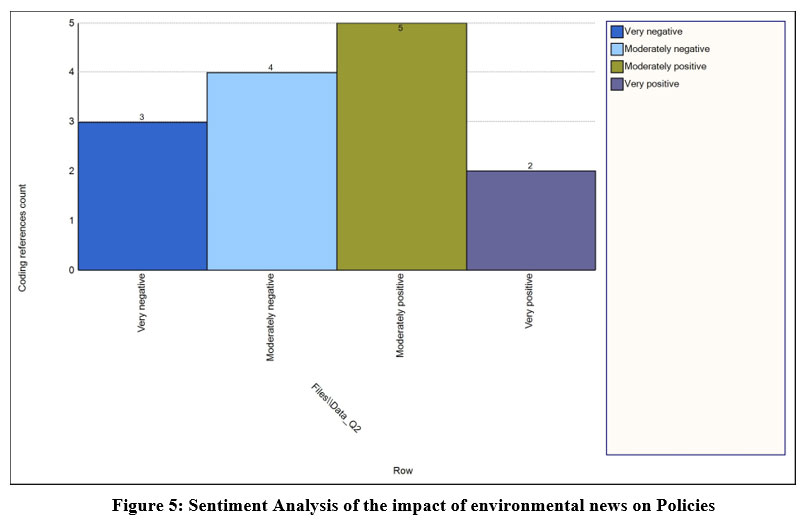 | Figure 5: Sentiment Analysis of the impact of environmental news on Policies
|
Looking at the word cloud in Figure 4, which was generated from the response of Question 2: "Can you share examples of environmental news stories that have had a significant impact on your perception of environmental issues or influenced your views on related policies? Words like "environment," "communication," "news," "climate," "media," "perception," "countries," and "coverage" were the most often used ones in the responses. Figure 5 presents the sentiment analysis of the query posed. From the figure, it can be seen that people's perceptions of environmental news have been shaped by negative tales they have encountered and seen. Even so, the graph also demonstrates moderately positive answers that have contributed to the formation of the impression.
 | Figure 6: Word cloud of Key factors Influence the Media
|
 | Figure 7: Sentiment Analysis of Key factors Influence the Media
|
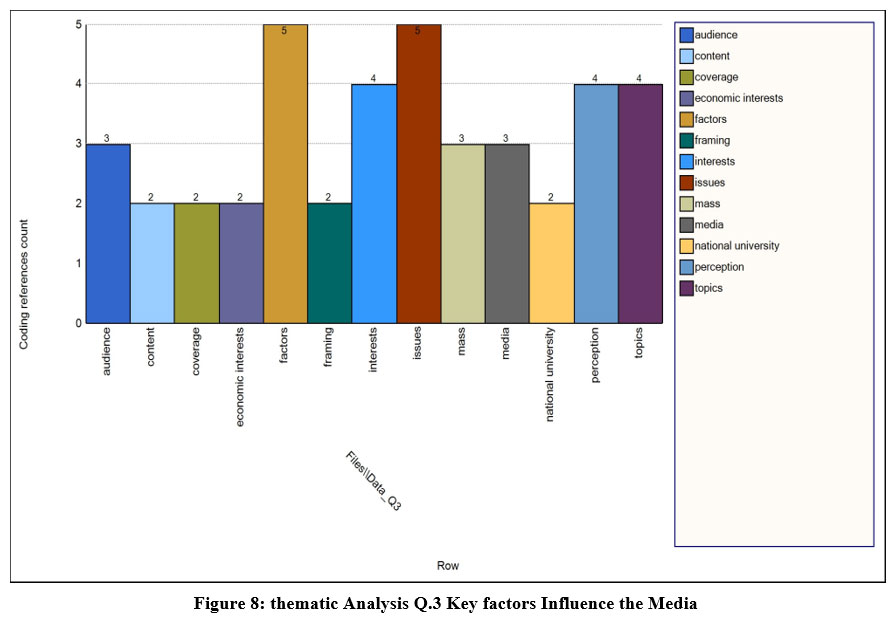 | Figure 8: thematic Analysis Q.3 Key factors Influence the Media
|
Question no 3 was “In your opinion, what are the key factors that influence the way environmental topics are covered in the media? Analyzing Figure 6, or the words cloud, reveals that words that demonstrate the impact of media coverage were sensationalism and consideration; these are linked to swaying public opinion. Words like "environment," "communication," "institutional communication," etc. come rapidly after these terms. The other key terms that came out of the analysis were politics, health, coverage, change, and public problems. One can see that 13 themes were developed based on the sentiment analysis shown in Figure 7 and the thematic analysis of the question shown in Figure 8. Based on the analysis of these themes, respondents have a moderately positive impression of media coverage of environmental concerns. It should be remembered that this study was carried out both before and after the G20 meeting.
 | Figure 9: Sentiment Analysis of Different way of covering news
|
 | Figure 10: thematic Analysis Different way of covering news
|
 | Figure 11: word Analysis of Different way of covering news
|
Question 4 of the FGD was “Have you noticed any differences in the way environmental issues are covered in print, digital, or broadcast media? How do these differences affect public understanding and policy discussions? The sentiment analysis in Figure 9 indicates that most of the responses were moderately positive, with a higher proportion of very positive responses than negative ones. Figure 10 is based on 12 themes that were extracted from the responses. By examining the responses, it is possible to determine that, when compared to print and electronic media, digital media is thought to be more effective in dealing with issues and raising public awareness in real-time. The word analysis in Figure 11 makes it evident that digital media has a greater impact on frequency. This shows that public opinion and people's perceptions and interactions with different issues are being greatly shaped by digital media. The increased frequency of terms associated with digital media suggests that its significance is expanding in today's society.
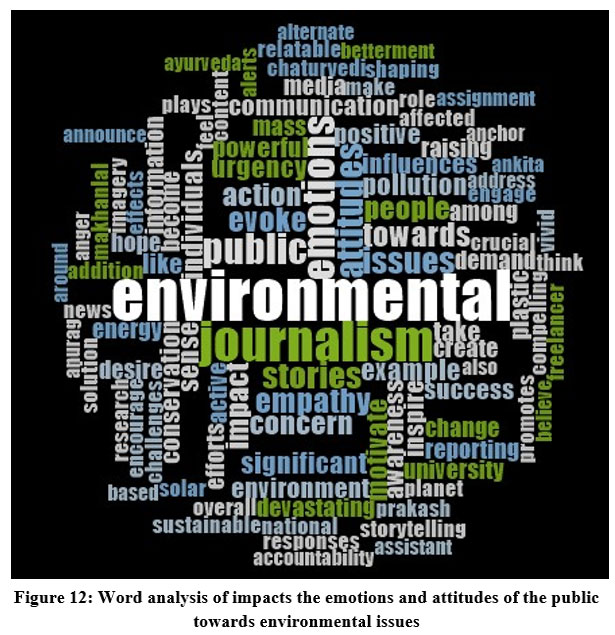 | Figure 12: Word analysis of impacts the emotions and attitudes of the public towards environmental issues.
|
 | Figure 13: Sentiment’s analysis of impacts the emotions and attitudes of the public towards environmental issues
|
When asked in Q.5 “How do you think environmental journalism impacts the emotions and attitudes of the public towards environmental issues? Can you provide specific examples?” Figure 12 shows that words like environmental, journalism, emotions, public, attitudes, actions, issues, etc. pop out for further understanding. With the help of Figure 13 sentiment analysis, one can find out that responses were both highly positive and moderately positive, which is a strong indication that individuals believe environmental journalism has a good influence on the public's opinions and feelings about environmental concerns. "Stories featuring personal experiences, vivid imagery, and data-driven reporting can evoke empathy, concern, and inspire action," was one of the examples given. "Deep reporting on the catastrophic effects of natural disasters like hurricanes or wildfires can inspire a desire for action to prevent future occurrences and elicit feelings of empathy towards affected communities," etc.
 | Figure 14: word Analysis balanced and objective coverage of environmental topics
|
 | Figure 15: Sentiment Analysis balanced and objective coverage of environmental topics
|
Question no 6 was “Do you believe that environmental journalists have a responsibility to provide balanced and objective coverage of environmental topics, or do they have a role in advocating for specific policies or perspectives? The majority of respondents think that environmental media necessitates advocacy journalism. Words with higher frequency, such as environmental, coverage, journalism, objective, responsibility, balanced, advocacy problems, etc., are also displayed in Figure 14-word count analysis. An intriguing finding when examining Figure 15 sentiment analysis is that neither extremely positive nor extremely negative opinions are depicted in the graph. The majority of replies were somewhat positive, but others were quite negative. These opinions demonstrate that, despite respondents' belief that environmental journalism advocacy should be carried out in a constructive way; replies were generally balanced and did not record many highly favorable ones. This suggests that respondents may have had mixed feelings about the effectiveness of environmental journalism advocacy. It is possible that they recognized the importance of constructive communication, but also felt the need to express their concerns or criticisms. Overall, the sentiment analysis reveals a nuanced range of opinions rather than extreme viewpoints.
 | Figure 16: Word analysis of the rise of social media as a new form of discussion on the environment
|
 | Figure 17: Sentiment Analysis of the rise of social media as a new form of discussion on the environment
|
Moving further to question no 7 “How has the rise of social media and citizen journalism influenced the way environmental issues are discussed and perceived? Are these platforms more or less effective than traditional journalism in shaping public perception? Figure 18 word analysis unambiguously displays terms like citizen journalism, social media, discussion, perception, journalism, and environment. After reviewing the results, it is evident that the majority of respondents believe that "because social media and citizen journalism are primarily people-centric and feedback-focused, they are way more effective in raising issues related to environmental journalism." On the other hand, it is evident from looking at the sentiment analysis in Figure 17 that most responses are either highly positive or somewhat positive. When discussing the crucial role that social media and citizen journalism play, very few replies were unfavorable. Those that were spoke about the misinformation and deception that these platforms and citizen journalism cause, as well as the lack of subject-matter expertise.
 | Figure 18: Word analysis of common biases used in environmental journalism
|
 | Figure 19: Sentiment Analysis of common biases used in environmental journalism
|
Question 8 focused on understanding the biases i.e. “From your perspective, what are some common biases or framing techniques used in environmental journalism? How might these affect public opinion and policy formation?” One can infer from the word analysis of Figure 18 that there were instances of sensationalism, bias, framing, and other undesirable meanings. The comments further demonstrate their belief that sensationalism, negative bias, framing, balanced bias, etc., render environmental media efforts ineffective. While there were also some moderately positive and very positive responses, Figure 19 sentiment analysis of the identical questions reveals that the bulk of responses were very negative and somewhat negative. These results indicate that sensationalism, bias, and framing are perceived by the public as problems in environmental journalism. The majority of somewhat and extremely negatively stated opinions in response to the questions show that this bad perception impairs the efficacy of work in this field.
 | Figure 20: Word analysis of improved to better serve
|
 | Figure 21: Sentiment analysis of improved to better serve
|
Question 9 asked “How can environmental journalism be improved to better serve the public and contribute to informed policy initiatives? Are there specific changes you'd like to see in the way these topics are covered? According to Figure 20 illustrates the word cloud analysis, people believe that more policy initiatives should be implemented, environmental journalism should receive more attention and be given dedicated sections in newspapers or social media portals, reporting should be more targeted, and public policies should be highlighted. Figure 21 shows the question's sentiment analysis was intriguing because every response was moderately positive. Therefore, every respondent believes that environmental journalism needs to be informed, and the previously indicated modifications were also suggested. These modifications were necessary to effectively raise awareness about environmental issues and promote informed decision-making among the public. Additionally, respondents emphasized the importance of collaboration between journalists, scientists, and policymakers to ensure accurate and impactful reporting on environmental matters.
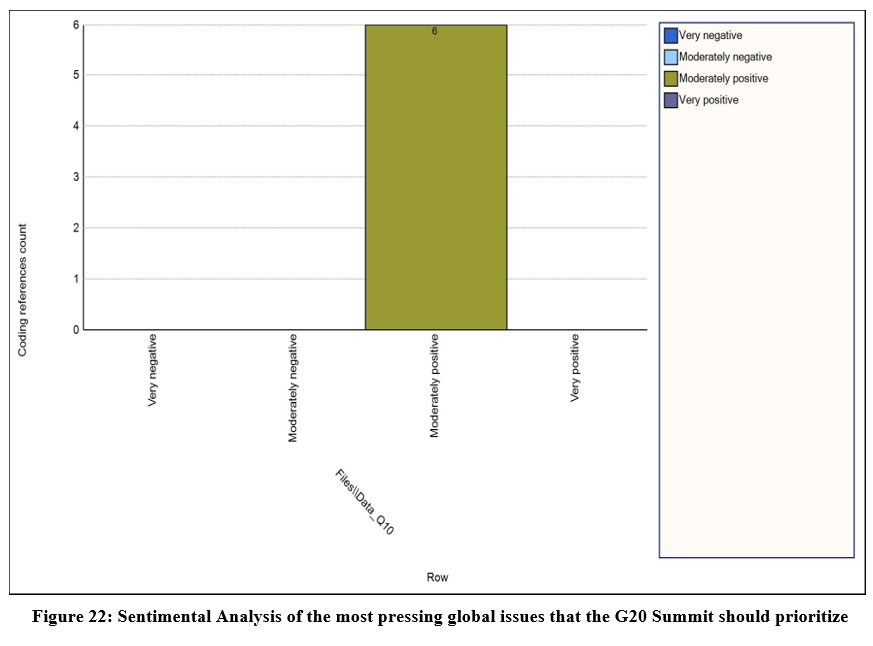 | Figure 22: Sentimental Analysis of the most pressing global issues that the G20 Summit should prioritize
|
And lastly, it was asked in question 10 “In your view, what are the most pressing global issues that the G20 Summit should prioritize and address? In your view, what are the most pressing global issues that the G20 Summit should prior? The thematic analysis presented in Figure 22 demonstrates how five themes—change, developing, global health, inequality, and sustainability—were developed from the replies. Hence, every respondent stated that appropriate development—which covers a wide range of subthemes—is the most important issue. Policies and communication about climate change, environmental sustainability, microplastic waste, migration, and other issues are urgently needed. The sentiment analysis in Figure 23 was particularly intriguing because every participant had a moderately positive response and no other responses were noted. This suggests that there is a consensus among the respondents regarding the importance of addressing these issues. It also indicates that there is a potential for widespread support and engagement in implementing policies and communication strategies to tackle these pressing concerns.
Secondary Data analysis
In this secondary data study, content from four websites—including data taken from The Times of India's website—was subjected to a thorough thematic analysis. These chosen domains were found through advanced Google searches between 1st August 2023 and October 31st. This study aims to find recurring themes, patterns, and trends in the information landscape of these chosen domains. The Researcher aims to provide significant insights into the important components and changing dynamics that surfaced within the given timeframe by methodically examining the digital content that is accessible on these platforms, with an emphasis on The Times of India's online presence.16 17 18
Thematic Analysis
The data from these websites are articles from The Times of India that report on different aspects of the environmental issue of energy transition and the climate crisis, such as the International Energy Agency’s (IEA) report on the net-zero scenario, the agreement between India and Saudi Arabia on electrical interconnections and green hydrogen, the challenges and opportunities of the energy sector in India, and the initiative of the Chandigarh municipal corporation (MC) to create potli bags out of recycled clothes. This thematic analysis aims to identify and discuss the main themes and messages that the articles convey about the environmental issue of energy transition and the role of different stakeholders and communities in it. I used a reflexive approach, which involves iterative and inductive cycles of coding and theme development, as well as recognition of the subjective nature of the research process. The researcher identified three main themes in the data: (1) The urgency and seriousness of the climate crisis and the need for radical action, (2) The feasibility and desirability of the net-zero scenario and the role of renewable energy and green hydrogen, and (3) The creativity and innovation of waste management and recycling solutions. I will discuss each theme in turn and provide examples from the data.
The urgency and seriousness of the climate crisis and the need for radical action: This theme captures how the articles portray the climate crisis as a pressing and critical problem that requires immediate and radical action from governments and society. The articles use strong and emphatic language to convey the sense of urgency and seriousness, such as “no new investments”, “from now – from this year”, “net-zero emissions”, “1.5 degrees Celsius”, and “stark contrast”. The articles also quote the IEA’s executive director Fatih Birol, who asserts that “If governments are serious about the climate crisis, there can be no new investments in oil, gas and coal, from now – from this year”. This statement implies that the current level of commitment and action from governments is insufficient and inadequate and that a fundamental shift in policy and mindset is needed to address the climate crisis. The articles also cite some statistics and projections, such as the record high of 37 billion tonnes of CO2 emissions in 2022, the expected growth of 7% a year in India’s steel demand until 2030, and the need to reduce emissions by 80% in advanced economies and 60% in emerging market and developing economies by 2035. These numbers show the magnitude and scale of the challenge and the gap between the current reality and the desired outcome.
The feasibility and desirability of the net-zero scenario and the role of renewable energy and green hydrogen: This theme captures how the articles present the net-zero scenario as a possible and preferable outcome that can be achieved by investing in renewable energy sources and reducing fossil fuel consumption. The articles use optimistic language to convey the sense of feasibility and desirability, such as “agreed to work together”, “enable us to exchange power”, “very important development”, and “looking forward to collaborating”. The articles also quote the ministers of India and Saudi Arabia, who express their enthusiasm and confidence in the cooperation on electrical interconnections and green hydrogen. The articles also cite the IEA’s report that says that renewable energy sources, such as solar, wind and hydro, should account for 90% of electricity generation by 2050, and that electric vehicles should make up 60% of car sales by 2030. The articles also highlight some of the benefits and opportunities of the net-zero scenario, such as the creation of millions of jobs, the improvement of air quality and health, and the avoidance of the worst impacts of climate change. The articles suggest that the net-zero scenario is not only feasible, but also desirable, as it can bring positive social, economic, and environmental outcomes for humanity and the planet.
The creativity and innovation of waste management and recycling solutions: This theme captures how the articles portray waste management and recycling solutions as creative and innovative ways to reduce the environmental impact of human activities and to generate value from waste. The articles use descriptive and appreciative language to convey a sense of creativity and innovation, such as “double bonanza”, “unique initiative”, “beautiful and colourful”, and “environment-friendly”. The articles also describe the initiative of the Chandigarh MC to create potli bags out of recycled clothes, which are distributed to the residents for free and also provide income to the self-help groups (SHGs) that make them. The articles also mention the Faith Pavilion at COP28, which is a platform for religious leaders and communities to showcase their efforts and contributions to tackling climate change and promoting environmental sustainability. The articles also cite the Chishty Foundation from Ajmer Sharif, which is participating in COP28 and raising awareness about the importance of waste management and recycling, especially in religious places. The articles imply that the waste management and recycling solutions are not only creative and innovative, but also inclusive and diverse, as they involve and benefit different stakeholders and communities, such as the MC, the S HGs, the residents, the religious leaders, and the pilgrims.
Conclusion
The NVivo analysis revealed positive public perceptions of environmental journalism, despite negative narratives. Participants praised deliberation and sensationalism in media coverage, with digital platforms being more efficient for real-time issues. Constructive communication was emphasized. In spite of disinformation worries, social media and citizen journalism were widely acknowledged for their enormous influence. It was believed that recognized biases and journalistic framing strategies, which frequently arouse unpleasant feelings, could compromise the efficacy of environmental journalism. More targeted reporting, policy initiatives, and increased participation from stakeholders and mainstream media were among the suggestions for improvement. Participants also emphasized important global concerns as top priority, including development, inequality, global health, climate change, and environmental sustainability. Overall, their comments showed a somewhat favorable tone.
Three main themes were found through the use of a reflective methodology and iterative coding cycles in the secondary data analysis. First, the pieces emphasized how urgent the climate situation is, using forceful language to communicate the need for governments and society to act quickly. Second, they underlined how feasible it is to invest in renewable energy sources and lessen dependency on fossil fuels in order to achieve a net-zero future. In conclusion, innovative approaches to trash management and recycling were deliberated, emphasizing the significance of involving numerous stakeholders to reduce ecological footprint. The research highlights the serious problems that climate change and the energy transition present, providing insightful information about the need to address these problems quickly, the possibility of sustainable solutions, and the significance of creative thinking in ensuring a sustainable future. When taken as a whole, these assessments highlight the critical role that knowledgeable, focused, and cooperative environmental media plays in tackling the most important environmental issues facing the planet.
Acknowledgement
The authors acknowledge Press Trust of India, Asain NEWS International, and Time of India; all the research papers cited for this work are highly appreciated. We also thank google analytics as the data extracted through Google advance search.
Funding Sources
The author(s) received no financial support for the research, authorship, and/or publication of this article.
Conflict of Interest
The author(s) do not have any conflict of interest.
Data Availability Statement
The manuscript incorporates all datasets produced or examined throughout this research study.
Ethics Statement
This research did not involve human participants, animal subjects, or any material that requires ethical approval.
Informed Consent Statement
This study did not involve human participants, and therefore, informed consent was not required.
Clinical Trial Registration
This research does not involve any clinical trials.
Author Contributions
All Authors' work equally in this article
References
- Anderson J, Rainie L. The positives of digital life. Pew Research Center: Internet, Science & Tech. July 3, 2018. Available at: https://www.pewresearch.org/internet/2018/07/03/the-positives-of-digital-life/. Accessed July 30, 2024.
- ANI. Faith Pavilion at COP28 will unite everyone to tackle climate change. Times of India. August 19, 2023. Available at: https://timesofindia.indiatimes.com/faith-pavilion-at-cop28-will-unite-everyone-to-tackle-climate-change-head-on-uae-minister/articleshow/102851930.cms. Accessed July 30, 2024.
- Sagar M. Double bonanza: MC “potlis” help environment & SHGs. Times of India. October 26, 2023. Available at: https://timesofindia.indiatimes.com/city/chandigarh/double-bonanza-mc-potlis-help-environment-shgs/articleshow/104713448.cms. Accessed July 30, 2024.
- Boykoff MT, Boykoff JM. Climate change and journalistic norms: A case study of US mass-media coverage. Geoforum. 2007;38(6):1190-1204. doi: 10.1016/j.geoforum.2007.01.008.
CrossRef - Dakers D. Environmental journalism. Crabtree Publishing Company; 2019.
- Environmental journalism. Environmental Communication and the Public Sphere. Available at: https://www.sagepub.com/sites/default/files/upm-binaries/90202_Chapter_5_Pages_from_Pezzullo_Environmental_Communication_and_the_Public_Sphere_5e.pdf. Accessed October 31, 2023.
- Environmental journalism and its challenges. WWF. Available at: https://wwf.panda.org/wwf_news/?158642/Environmental-journalism-and-its-challenges. Accessed July 30, 2024.
- Lambert SD, Loiselle CG. Combining individual interviews and focus groups to enhance data richness. J Adv Nurs. 2008;62(2):228-237. doi:10.1111/j.1365-2648.2007.04559. x.
CrossRef - McComas K, Shanahan J. Telling stories about global climate change. Commun Res. 1999;26(1):30-57. doi:10.1177/009365099026001003.
CrossRef - McCombs M, Valenzuela S. Setting the Agenda: Mass Media and Public Opinion. 3rd ed. John Wiley & Sons; 2021. (Original work published 2014).
- Mont O, Lehner M, Dalhammar C. Sustainable consumption through policy intervention—A review of research themes. Front Sustain. 2022;3. doi:10.3389/frsus.2022.921477.
CrossRef - Muhammad Ittefaq, Kamboh SA, Ashfaq A. Climate Change Journalism in Pakistan. Routledge EBooks; 2023:419-429. doi:10.4324/9781003298144-44.
CrossRef - Neel Kamal. No investment in new coal, oil, natural gas should be made: IEA. Times of India. September 23, 2023. Available at: https://timesofindia.indiatimes.com/business/ india-business/no-investment-in-new-coal-oil-natural-gas-should-be-made-iea/articleshow/103966861.cms. Accessed July 30, 2024.
- Poornananda DS. Environmental Journalism. SAGE Publishing India; 2022.
- PTI. India, Saudi Arabia tie up for electrical interconnections, green hydrogen. Times of India. October 8, 2023. Available at: https://timesofindia.indiatimes.com/business/ india-business/india-saudi-arabia-tie-up-for-electrical-interconnections-green-hydrogen/articleshow/104262529.cms. Accessed July 30, 2024.
- Sampaio J, Kääpä P, Costa L. Environmental journalism: Characteristics and interfaces in a developing field. Intercom. 2022;45. doi:10.1590/1809-58442022109en.
CrossRef - Sundbeck J. Journalism and climate change in a developing country. [Thesis]. Available at: http://www.diva-portal.se/smash/get/diva2:1394670/FULLTEXT01.pdf. Accessed July 30, 2024.
- Wonneberger A, Meijers MH, Schuck ART. Shifting public engagement: How media coverage of climate change conferences affects climate change audience segments. Public Underst Sci. 2019;29(2):096366251988647. doi:10.1177/0963662519886474
CrossRef






